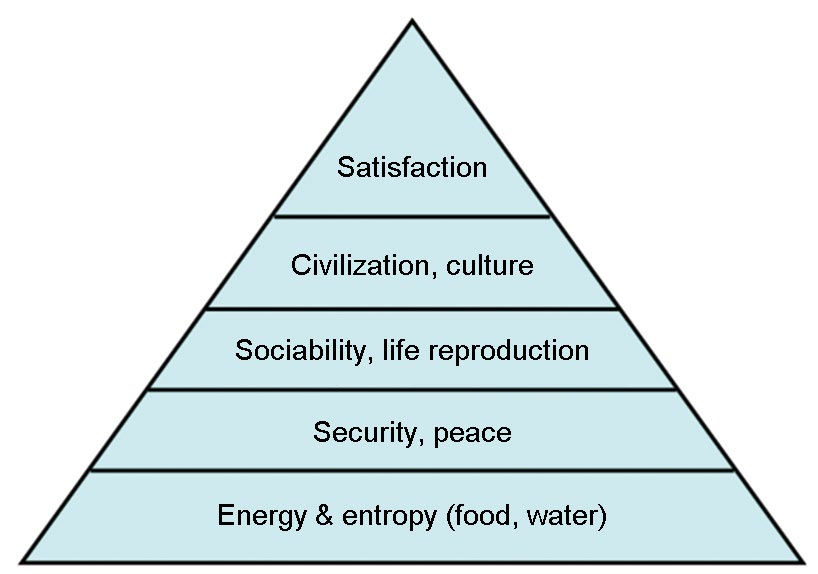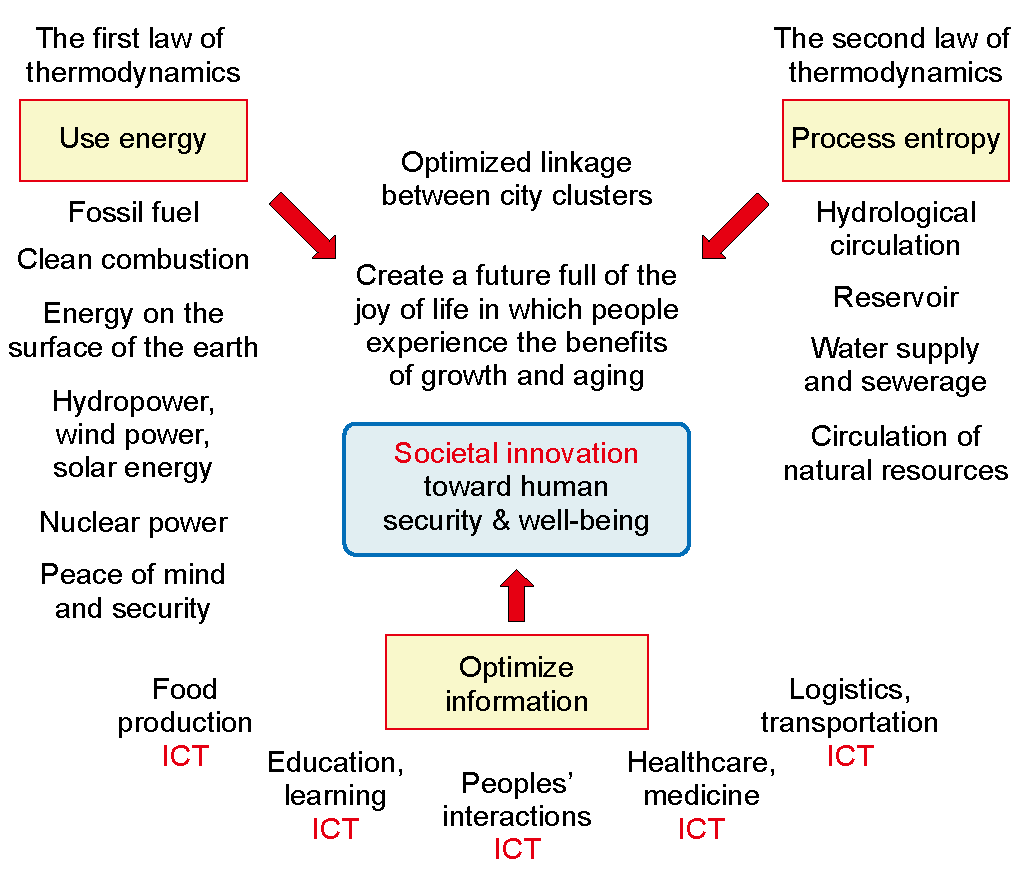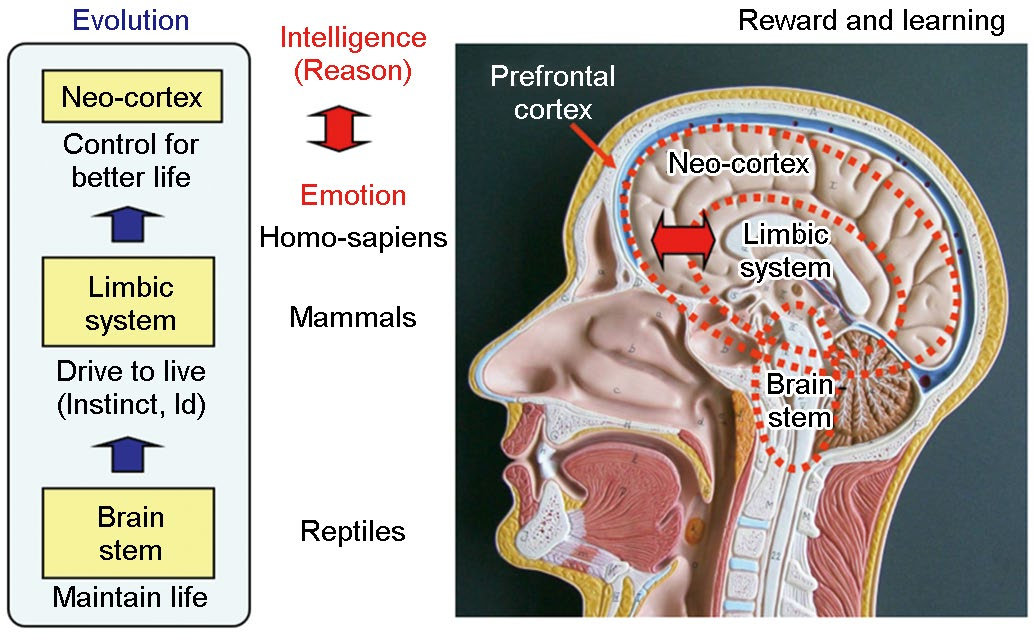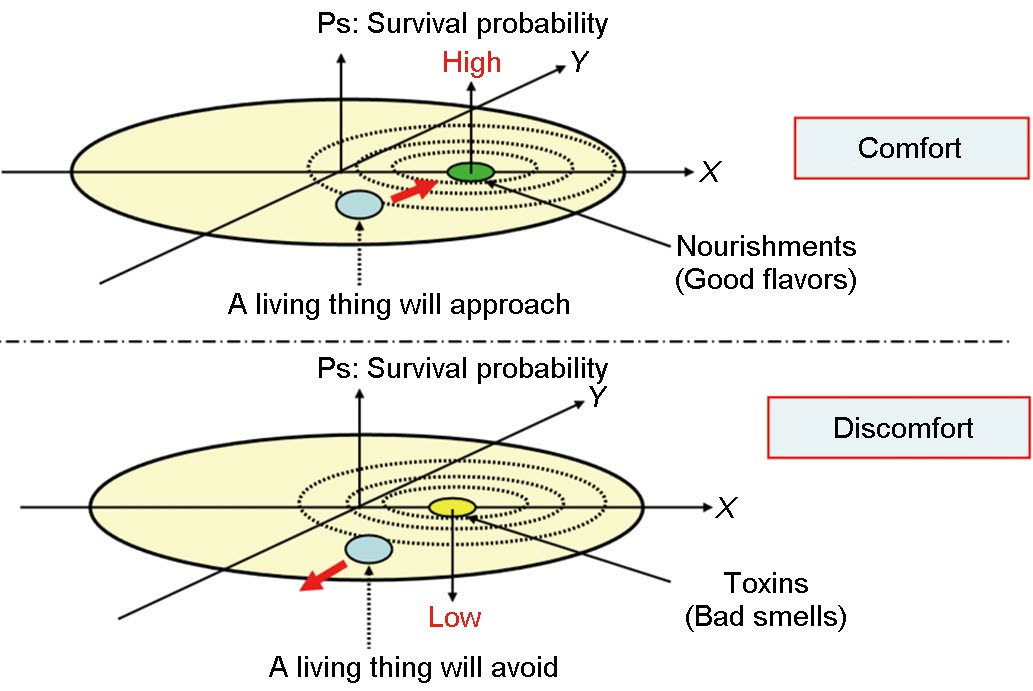For some time, I have been studying the combined concept of “human security and well-being,” which addresses people’s daily lives as a top priority, as well as the concept of “societal innovation.” The concept of “human security” was born in the early 1990s, replacing the idea of “common security.” Human security covers cooperation between nations toward common threats to the human race as a whole, such as global warming and pandemics. On the other hand, the concept of “well-being” is proactive, encompassing happiness and quality of life (QOL). Societal innovation links science and engineering in information and communications with societal infrastructure, ensuring that new systems that are useful to society emerge and are implemented based on proven technology. This area of study resolves various issues affecting people in general, thus contributing to the good of the whole.
Pressing issues exist today, involving energy, the environment, healthcare (including mental health), education, transportation, food, and aging. In the quest for human security and well-being, societal innovation provides the driving force to resolve these issues. Future urbanization concepts will require a master plan to address all of the issues listed above. Individual methods to achieve such a master plan will require a wide variety of innovations and technological developments.
Given that the original meaning of innovation is “creation through new bonding,” the idea of “co-creation” (open innovation) is indispensable in societal innovation. By strengthening links between the humanities, social sciences, and other areas, and by bridging and fusing areas where necessary, new systems will emerge. To this end, the science of brain functions will become increasingly important. This is because the brain is a common information processor for natural science, social science, and the humanities.
For many years, we have pursued various methods to generate synergies in the key areas of measurement, analysis, and control technology. The current pressing issue in this work is to ensure that information and communication technology (ICT) spreads to all areas of societal infrastructure. In addition, connections between science and engineering in the field of life sciences are creating new frontiers for the 21st century. Examples include brain science and regenerative medicine, with a particular focus on induced pluripotent stem (iPS) cells.
《Council of Academies of Engineering and Technological Sciences meeting minutes (2011)》
Council of Academies of Engineering and Technological Sciences meeting minutes (2011)
On the occasion of the Council of Academies of Engineering and Technological Sciences (CAETS) Convocation, held in 2011 in Mexico City, I was granted the opportunity to acknowledge and thank the CAETS member countries who had extended support and warm sympathy to Japan after the East Japan Great Earthquake of March 11, 2011. My address at the opening of the council meeting was later attached to the CAETS homepage by the CAETS Secretary. After the earthquake, a number of Japanese engineers including myself had to return to basics to guide our way of thinking. For example, does materialistic prosperity ensure happiness or well-being? What is most important to us as human beings? What is the final destination of engineering—the true objective of engineering?
《Reconstruction of the Tohoku disaster area》
Reconstruction of the Tohoku disaster area
Many Pacific seaside towns in the Tohoku area were completely destroyed by the huge tsunami that hit them on March 11, 2011 (Figure 1). Almost 20 000 lives were lost. Although three years have passed, reconstruction has proceeded extremely slowly in this seaside disaster area. This situation exemplifies the difficulty of new urbanization in the context of human security and well-being.
《Fig. 1》

Fig.1 Onagawa Town disappeared after being hit by a tsunami that was over 20 m high, on March 11, 2011. Photo by H. Koizumi, 2012.
《The original form of a city》
The original form of a city
The ruin of an ancient Greek city shown in Figure 2 is an example of the original form of a city. Selinunte was a colony of ancient Athens, established in Sicily more than 2500 years ago. This city was situated on a flat hill near the shore of the Mediterranean Sea.
《Fig.2》

Fig.2 The original form of a city: Selinunte, an ancient Greek city in Sicily (BC 628). Photo by H. Koizumi.
The Acropolis was the center of Selinunte; this area was respected by citizens, and city governance was performed here. The whole city was surrounded by high walls for protection, as was usual at that time. The fundamental city form and functions of Selinunte make up an original form of a city, or an archetype as was first pointed out by Goethe in his concept of morphology. A city evolves from its basic form through metamorphosis.
《Human-centric design》
Human-centric design
When discussing the concept of a smart city, we often discuss specific means to achieve it, such as a smart grid or environmental concerns. When we think of a future city, however, we should not start from means but from final objectives. A city is a place where humans live. Therefore, our first priority should be to make such a city “human centric” or “human centered.”
What is a future city like? Figure 3 shows a proposal for a human-centered future city. Here, human security and well-being are the key concepts, and societal innovation is used to make optimal city clusters. For optimization we have to consider all the issues of energy, environment, logistics, transportation, healthcare, education, and food production as mentioned later.
《Fig. 3》

Fig.3 The concept of a human-centered future city<FootNote>H. Koizumi. A vision for future city (Special lecture). Hitachi Forum, Dalian, 2012</FootNote>.
The optimization of whole city clusters has not been studied yet. I have been advocating this new transdisciplinary field as a typical example of a new concept that integrates science, engineering, and technology.
《SET concept toward innovation》
SET concept toward innovation
The traditional phrase “science & technology” is not necessarily the best expression to describe practical research and development. I have had the good fortune to invent many new methodologies and discover various new phenomena. In my opinion, there are three orthogonal concepts, science, engineering, and technology (SET), in every kind of research and development.
Modern concepts of science, engineering, and technology (including the arts) have been nurtured somewhat independently in different fields since the 17th century. Consider the word stem of science, scie, coming from the old Greek word skei, which means to split or divide. The original meaning of “science” is to know and to understand nature by reduction. The word stem of engineering, gin, comes from the old Greek word gen, which means to give birth. Therefore, the original meaning of “engineering” is to create human artifacts. The word stem of technology, techn, comes from the old Greek word tekhne, which means to make or imitate natural existence. The meaning of tekhne is the same as that of the Latin word ars, from which we get “arts.” Therefore, the original meaning of technology is similar to that of the arts.
I have to emphasize that human activities in science are not directly related to ethics. Human activities in engineering, however, should be highly concerned with ethics. Global warming and the tragedy of nuclear bombs are both the results of human artifacts, that is, the results of engineering based on human decisions.
《A hierarchical structure for human security and well-being》
A hierarchical structure for human security and well-being
I have modified Maslow’s hierarchy of needs from a human-centered perspective (Figure 4). The first layer, the most basic, consists of energy and entropy. This layer relates to the air, water, and nutrition required for life. The second layer consists of security, such as safety, and various guards for survival. The third layer consists of sociability, such as relationships with others, and life reproduction. These three basic layers are related to the so-called “food, clothing, and housing” needs. The fourth and fifth layers, at the top of the pyramid, are strongly related to human thinking and states of mind, and include concepts such as civilization, culture, and satisfaction. In the lower three layers, happiness is proportional to fulfillment. In the upper two layers, however, happiness is not necessarily proportional to money and material prosperity. Although materialistic values are important in developing human states of existence, mental values become more important in highly developed states.
《Fig. 4》

Fig.4 Hierarchical structure for human security and well-being. Adapted from “Maslow’s hierarchy of needs” from physical and mental viewpoints.
《A human-centered future city》
A human-centered future city
When we consider a human-centered future city, we have to consider energy production and entropy processing from a physics viewpoint. These two factors are closely related to the first and second laws of thermodynamics, respectively. The expanded concepts of energy and entropy include the mass of material and information, respectively. Therefore, we have to consider these fundamental factors in a transdisciplinary manner in order to realize societal innovations that lead to human security and well-being. A basic necessity for holistic clusters of towns and cities is the optimal allocation of resources for healthcare, education, logistics and transportation, food production, and so on, as well as for energy production and entropy processing.
《New urbanization of holistic city clusters》
New urbanization of holistic city clusters
Historically, a town or a city naturally formed as a result of the existence of something that gathered people together, such as a castle, a temple, a market, or a port. The increased gathering of people then became a driving force to expand the city. Next, a big city would often produce satellite cities and towns, leading to further expansion. Urban designers and city planners often worked to develop and reform urban areas. The city of Canberra is an exception to this gradual process of city development, as it was artificially constructed from the beginning as the capital city of Australia. The construction started in 1913 and almost ended at 1988 with the completion of the new Houses of Parliament on the Capital Hill. The history of Canberra showed us the difficulty to plan and construct even a single artificial city.
I have been in discussion with many architects, city/landscape designers, and developers, including the designers of Canberra, Singapore, and more. However, almost no major architect or city planner has worked to design holistic clusters of towns and cities with optimized interconnections between whole cities (Figure 5). This is a Copernican change in urban design, which therefore requires a new field of SET. This kind of thinking is necessary in the reconstruction of the towns that disappeared under the unexpected Great Tsunami. In particular, it can be applied to the new urbanization trial to be prepared in China, called “城镇化” or “Chinese new urbanization” (Figure 6).
《Fig. 5》

Fig.5 The concept of a holistic system of the clusters of cities<FootNote>H. Koizumi. A vision for future city (Special lecture). Hitachi Forum, Dalian, 2012</FootNote>.
《Fig. 6》

Fig.6 A new urbanization concept of holistic city clusters<FootNote>Discussed in NDRC’s China International Urbanization Forum 2013, Shanghai. H. Koizumi. A vision for future city (Special lecture). Hitachi Forum, Dalian, 2012</FootNote>.
《A new concept of neuro-metabolic urbanization》
A new concept of neuro-metabolic urbanization
Nature, including humans, consists of two components: energy/matter and entropy/information. I refer to this idea as “physical dualism” or “modern dualism,” based on two fundamental laws of nature, the first and second laws of thermodynamics; that is, the conservation of energy and the increase of entropy, respectively.
Through physical dualism, a new concept for a methodology to create holistic city clusters can be derived from a human’s life systems. I refer to this concept as “neuro-metabolism” as compared to the concept of “metabolism” in architectonics.
I would like to consider again the physical aspect of the basic level for the optimization of holistic city clusters; in other words, the relationship between energy/matter and entropy/information. The equation of the retention time of a system, clarified by Schrödinger, suggests a deeper meaning to sustainability.
Systems retention time ( t) can be shown as following equation according to Schrödinger:

where τ = 10−13−10−14 by Schrödinger; k is Boltzmann constant; and T is absolute temperature.
《The thermal grand engine》
The thermal grand engine
From a physics viewpoint, the Earth’s biosphere is driven by a grand thermal engine, formed by the high surface temperature of the sun at 5800 K, and the low temperature of the universe at 3 K. Earth receives high-energy and low-entropy photons from the sun, and emits low-energy and high-entropy photons to the universe. All life in the biosphere is linked to this grand thermal engine. Life, including humans, can be defined as a self-reorganizing system that operates by means of energy and entropy processing.
《The evolution of life in the Proterozoic Eon and the Paleozoic Era》
The evolution of life in the Proterozoic Eon and the Paleozoic Era
Figure 7 depicts the evolution of life in fossils. Cyanobacteria appeared on Earth at a very early stage in evolution, around 3.45 billion years ago. They brought oxygen to the Earth’s atmosphere, and formed stromatolite fossils. Next, trilobites appeared in the Cambrian period, after the Ediacaran period. More than 10 000 species of trilobites evolved though the Devonian period, but all of them disappeared. Precise multiple eyes evolved in trilobites; these eyes were the first efficient information detectors of the environment. Since the two eyes of a trilobite are formed from calcite, we can see them clearly even in fossils. The beginning of animal’s evolution gives us a lot of hints in considering on humans nature.
《Fig.7》

Fig.7 The evolution of life in the Proterozoic Eon and the Paleozoic Era. Photos by H. Koizumi.
《The evolution of life from an informational viewpoint》
The evolution of life from an informational viewpoint
Figure 8 shows the evolution of life from an informational viewpoint. Information for adaptation to the surrounding environment or to environmental changes has been accumulated as genetic information in the genome since the evolution of eukaryotes. The central nervous system then evolved over a few hundred million years. Humans process information in the central nervous system, mainly the brain, much more than through their genetic information. For example, an extremely evolved prefrontal cortex may be responsible for the concept of dignity in humans.
《Fig. 8》

Fig.8 The evolution of life from an informational viewpoint.
《The evolution of the brain system for information processing》
The evolution of the brain system for information processing
The human brain evolved from the center out (Figure 9). The shape of the brainstem, the central part of the brain, looks like an earlier-evolved reptilian brain. The limbic system was the next part of the brain to evolve. The highly evolved human neo-cortex is related to intelligence or reasoning, while the human limbic system is related to emotion. The understanding of human brain structure is an important factor in the creation of human-centered holistic city clusters.
《Fig.9》

Fig.9 The evolution of the brain system for information processing.
《The difference between human beings and chimpanzees》
The difference between human beings and chimpanzees
Major differences exist between humans and chimpanzees. After working with many scholars and scientists, including primate researchers, we came up with the following hypothesis of what distinguishes a human being from other forms of life*
(1) Has language ability based on hierarchic grammar;
(2) Makes and uses complicated tools;
(3) Educates offspring;
(4) Has high-level emotions such as compassion or hatred;
(5) Has a clear concept of the future.
The evolution of language drastically accelerated information processing in the human brain. Humans can think using language and symbols that cover an overwhelmingly long time span from past to future.
《Only humans can create the future》
Only humans can create the future
Humans can use language for information processing even in the subconscious, resulting in the brain’s ability to transcend time and space, within the realm of the imagination.
While animals other than humans have only a simple future, humans have both a simple future and a volitional, or consciously chosen, future. This volitional future is what allows us to plan and optimize holistic future city clusters for human security and well-being.
《Survival probability with comfort/discomfort》
Survival probability with comfort/discomfort
All animals—from primitive animals to humans—behave according to feelings of comfort/discomfort. We believe that the feeling of comfort/discomfort works as a survival compass, directing us how to behave. The selection of a more comfortable environment improves our survival probability. A comfortable temperature is good for one’s health; a good smell leads to nourishment; and sexual pleasure leads to the preservation of the species (Figure 10).
《Fig. 10》

Fig.10 Survival probability with the comfort/discomfort basis-of-reward system<FootNote>H. Koizumi, JST Symposium, 2008. H. Koizumi. The Science History of the Brain. Tokyo: Kadokawa Press, 2011</FootNote>.
《Generating the feeling of happiness》
Generating the feeling of happiness
In animal studies, the striatum works as the reward system in the brain, especially for prediction. If a reward prediction is made in advance in an animal brain, the animal behaves in a certain way in order to get the reward. Even in the case of a monkey, the advance prediction time before getting a reward as observed in experiments is short: less than 20 seconds. However, humans can predict various kinds of rewards years in advance. For example, if a person believes that he will be able to buy a nice house a year later by working hard at his job, his job may become pleasurable as a result of anticipating the reward. This aspect is unique to human beings and leads to the mechanism of feeling happy.
《Activation of the striatum by social reward》
Activation of the striatum by social reward
Recently, as part of our national program, Professor Sadato’s group at the National Institute of Physiology discovered that the striatum of subjects was clearly activated when they were evaluated highly as a socially respectful person (Figure 11). In humans, this area responds similarly to a monkey’s striatum when it gets a banana as a reward for success in training (reinforcement learning).
《Fig. 11》

Fig.11 Activation of the striatum by social reward<FootNote>N. Sadato’s Group, NIPS. Japan’s Children’s Study (JCS), RISTEX/JST. Area Director: H. Koizumi; K. Izuma, D. N.Saito, N. Sadato, Neuron, 2008</FootNote>. (a) Caudate nucleus in striatum; (b) putamen in striatum.
《Development of noninvasive brain-function imaging》
Development of noninvasive brain-function imaging
The most important and difficult issue in noninvasive human brain-function imaging is that two contradictory requirements must be simultaneously satisfied. One requirement is to reduce the interaction between human tissue and irradiated probing photons. The other is to obtain a good enough signal-to-noise (SN) ratio to produce an image with high temporal and spatial resolution.
Only the highest quality technologies can solve this problem. We worked hard to develop various new technologies to address this issue, and filed many patent files in the field of MRI as a result (Figure 12). We also developed a functional magnetic resonance imaging (fMRI) machine in 1992, then developed optical topography and subsequently succeeded in obtaining images of higher-order brain functions. This method can be used to test subjects under natural conditions. We published the world’s first paper on optical topography in 1995.
《Fig. 12》

Fig.12 Magnetic resonance imaging (MRI)/Magnetic resonance angiography (MRA) (MRH-500 developed in 1990 by Hitachi, Ltd. as an example).
In optical topography, flexible optical fibers with a diameter of 1 mm are placed between hair roots on the scalp. Near-infrared light enters the brain and is affected by changes in the concentration of oxy-, deoxy-, and total hemoglobin levels, which are induced by neuronal activity. The photon paths were calculated through a Monte Carlo simulation.
For example, optical topography can give us images of brain activity during the act of writing. Activation is visible in both Broca’s area and Wernicke’s area. Broca’s area, on the left frontal lobe, is for word generation, whereas Wernicke’s area, on the left temporal lobe, is for word comprehension.
《Optical topography test for psychiatric diagnoses》
Optical topography test for psychiatric diagnoses
We have been working to realize a diagnostic tool for mental diseases in collaboration with psychiatrists since 1996. Recently, remarkable progress has been made in clinical psychiatry. In 2011, Nature magazine reported this diagnostic methodology as its News Feature, titled Neuroscience: Thought experiment (Feature News, Nature, 2011, vol. 269). While emphasizing the importance of this new methodology, Nature also pointed out that the number of clinical results was still insufficient. However, large inter-hospital examinations had already been performed by that date, and big data were reported soon after the article was published. The Japanese government has already officially approved this optical topography test as a diagnostic-support tool for psychiatrists to discriminate between diagnoses of depression, bipolar, and schizophrenia diseases in patients in depressive states.
Mental issues are very important in urban life, since they are a frequent source of mental stress for its inhabitants. The population of the world living in urban areas exceeds 50%. Solving mental problems caused by a stressful life in the city must be a major consideration in planning and constructing new holistic clusters of future cities.
《Conclusions》
Conclusions
(1) The concept of engineering for human security and well-being could be a key issue for the future of engineering. Here, the close collaboration between science, engineering and technology must be the key for the future.
(2) A new urbanization could be a key as a platform of human’s life. Here, the system optimization of holistic city clusters must be very important.
(3) The human being could be only a species to be able to consider the future. We have to plan a controlled better future for human security and well-being.
(4) Ethics is more important in the activities of engineering than those of science.













 京公网安备 11010502051620号
京公网安备 11010502051620号




